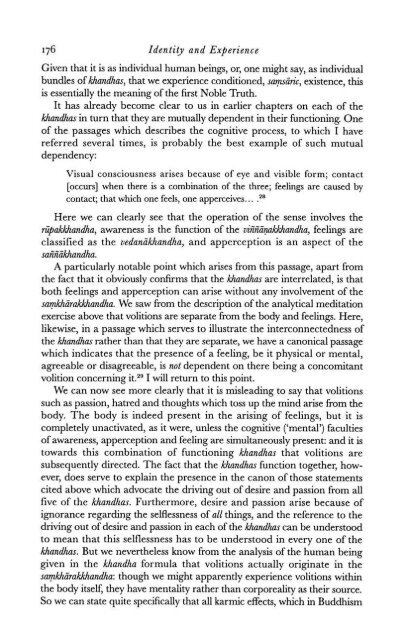Identity and Experience_Hamilton_1996
Identity and Experience_Hamilton_1996
Identity and Experience_Hamilton_1996
Create successful ePaper yourself
Turn your PDF publications into a flip-book with our unique Google optimized e-Paper software.
176 <strong>Identity</strong> <strong>and</strong> <strong>Experience</strong><br />
Given that it is as individual human beings, or, one might say, as individual<br />
bundles of kh<strong>and</strong>has, that we experience conditioned, savim'c, existence, this<br />
is essentially the meaning of the first Noble Truth.<br />
It has already become clear to us in earlier chapters on each of the<br />
kh<strong>and</strong>has in turn that they are mutually dependent in their functioning. One<br />
of the passages which describes the cognitive process, to which I have<br />
referred several times, is probably the best example of such mutual<br />
dependency:<br />
Visual consciousness arises because of eye <strong>and</strong> visible form; contact<br />
[occurs] when there is a combination of the three; feelings are caused by<br />
contact; that which one feels, one apperceives.. , .28<br />
Here we can clearly see that the operation of the sense involves the<br />
rtipakkh<strong>and</strong>ha, awareness is the function of the vin"n"i&kh<strong>and</strong>ha, feelings are<br />
classified as the uedanikh<strong>and</strong>ha, <strong>and</strong> apperception is an aspect of the<br />
sa ECikh<strong>and</strong>ha.<br />
A particularly notable point which arises from this passage, apart from<br />
the fact that it obviously confirms that the kh<strong>and</strong>has are interrelated, is that<br />
both feelings <strong>and</strong> apperception can arise without any involvement of the<br />
sapkhirakkh<strong>and</strong>ha. We saw from the description of the analytical meditation<br />
exercise above that volitions are separate from the body <strong>and</strong> feelings. Here,<br />
likewise, in a passage which serves to illustrate the interconnectedness of<br />
the kh<strong>and</strong>has rather than that they are separate, we have a canonical passage<br />
which indicates that the presence of a feeling, be it physical or mental,<br />
agreeable or disagreeable, is not dependent on there being a concomitant<br />
volition concerning it.29 I will return to this point.<br />
We can now see more clearly that it is misleading to say that volitions<br />
such as passion, hatred <strong>and</strong> thoughts which toss up the mind arise from the<br />
body. The body is indeed present in the arising of feelings, but it is<br />
completely unactivated, as it were, unless the cognitive ('mental') faculties<br />
of awareness, apperception <strong>and</strong> feeling are simultaneously present: <strong>and</strong> it is<br />
towards this combination of functioning kh<strong>and</strong>has that volitions are<br />
subsequently directed. The fact that the kh<strong>and</strong>has function together, however,<br />
does serve to explain the presence in the canon of those statements<br />
cited above which advocate the driving out of desire <strong>and</strong> passion from all<br />
five of the kh<strong>and</strong>has. Furthermore, desire <strong>and</strong> passion arise because of<br />
ignorance regarding the selflessness of all things, <strong>and</strong> the reference to the<br />
driving out of desire <strong>and</strong> passion in each of the kh<strong>and</strong>has can be understood<br />
to mean that this selflessness has to be understood in every one of the<br />
kh<strong>and</strong>has. But we nevertheless know from the analysis of the human being<br />
given in the kh<strong>and</strong>ha formula that volitions actually originate in the<br />
samkhimkkh<strong>and</strong>ha: though we might apparently experience volitions within<br />
the body itself, they have mentality rather than corporeality as their source.<br />
So we can state quite specifically that all karmic effects, which in Buddhism


